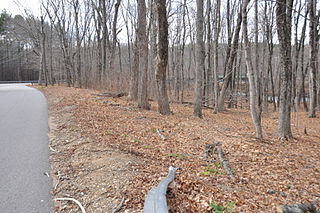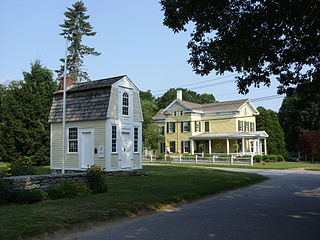
The Washington–Rochambeau Revolutionary Route (W3R) is a 680-mile-long (1,090 km) series of roads used by the Continental Army under the command of George Washington and the Expédition Particulière under the command of Jean-Baptiste de Rochambeau during their 1781 march from Newport, Rhode Island to Yorktown, Virginia. The route is a designated National Historic Trail (2009) with interpretive literature, signs, and exhibits that describe the key role of French diplomatic, military, and economic aid to the United States during the American Revolutionary War.

The Waterman Tavern is a historic house and tavern at 283 Maple Valley Road, near Whaley's Hollow in Coventry, Rhode Island. The 2-1/2 story wood-frame house was built some time before 1747 by John Waterman, who was licensed to operate a tavern on the premises in that year. It is five bays wide with a central chimney. The site was advantageously located on what was then the main road between Providence and Plainfield, Connecticut. The tavern was a center of civic discourse, and town meetings were regularly held there until 1835.
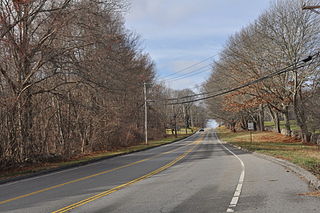
The March Route of Rochambeau's Army: Scotland Road is a historic road section in Windham, Connecticut. Extending along Scotland Road, from itsintersection with Back Rd. to 80 Scotland Road in, it is an evocative portion of the historic march route of the French Army under the Comte de Rochambeau in 1781 and 1782 during the American Revolutionary War. The troops camped beside the road within this segment in 1782. It was listed on the National Register of Historic Places in 2003.
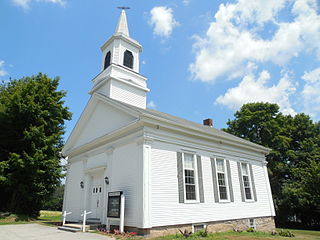
The Sterling Hill Historic District encompasses a well-preserved early 19th-century rural village center on western edge of the town of Sterling, Connecticut. Centered at the junction of Plainfield Pike and Sterling Hill Road, it consists of a cluster of 19th and early 19th-century houses, and a church. Unlike other period villages, it has largely been unaffected by later development. It was listed on the National Register of Historic Places in 1986.

The Newtown Borough Historic District is a 100-acre (40 ha) historic district in the borough of Newtown within the town of Newtown in Fairfield County, Connecticut. There is a local historic district, and an overlapping district that was listed on the National Register of Historic Places in 1996.

The Dorrance Inn, also known as the Samuel Dorrance House, is a historic former inn at 748 Plainfield Pike in Sterling, Connecticut. Built about 1722, it is notable as a place that hosted officers of the French Army in 1781 and 1782, as it was along the march route taken by French commander Rochambeau's troops en route to Yorktown, Virginia. Dorrance's Inn is one of a few places mentioned by name in multiple accounts written by French officers. The building was individually listed on the National Register of Historic Places in 2002. and is a contributing building in the Sterling Hill Historic District.

The Forty-Seventh Camp of Rochambeau's Army is a historic military camp site in Windham, Connecticut. Located along Scotland Road a short way east of Windham Center, it was the site of a French Army camp in November 1782, when that army was en route from victory at Yorktown to Rhode Island. The camp site is considered of archaeological importance, because it can shed light on transient military camp sites, whose locations are not often known. It was listed on the National Register of Historic Places in 2003.

March Route of Rochambeau's Army: Manship Road-Barstow Road is a historic site in Canterbury, Connecticut that was listed on the National Register of Historic Places in 2003, for its evocation of the march route French commander Rochambeau's troops in 1781 and in 1782.
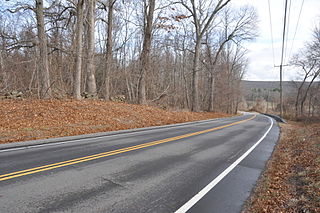
The March Route of Rochambeau's Army: Palmer Road is a linear historic district encompassing a portion of Connecticut Route 14 in eastern Scotland, Connecticut. It was listed on the National Register of Historic Places in 2003 as an evocative surviving element of the march route of the French Army commanded by Rochambeau during the American Revolutionary War in 1781 and 1782.

March Route of Rochambeau's Army: Plainfield Pike is a 3.6 mile-long road segment in Plainfield and Sterling, Connecticut which forms a portion of the historic march route of Comte de Rochambeau's army in June 1781 on its way to Yorktown, Virginia, and again of the returning army in November 1782. It was listed on the National Register of Historic Places (NRHP) in 2003.

The March Route of Rochambeau's Army: Bailey Road is a section of abandoned, old roadway that is a historic site in Bolton, Connecticut. It was listed on the National Register of Historic Places in 2003. The roadway is one of the most intact sections in Connecticut of the march route taken by French troops under the command of the Count de Rochambeau in 1781.

The Daniel Basset House is a historic house a 1024 Monroe Turnpike in Monroe, Connecticut. It is a 2-1/2 story wood frame structure, five bays wide, with two brick chimneys and a side gable roof. Its centered entrance is flanked by sidelight windows and pilasters, and is topped by a transom window. The second floor extends slightly over the first floor on the front (west-facing) facade. Built in 1775, the house is significant for its association with events in the American Revolutionary War. It is along the march route taken by French commander Rochambeau's troops in 1781 en route to Yorktown, Virginia and possibly during their return. A ball was held in the house's second-floor ballroom for the French officers of Lauzun's mounted section of Rochambeau's army on June 30, 1781, which camped nearby.

Camps Nos. 10 and 41 of Rochambeau's Army, also known as Site No. 97-87D, is an archeological site that was listed on the National Register of Historic Places in 2002.

March Route of Rochambeau's Army: Reservoir Road is a historic site in Newtown, Connecticut. It was listed on the National Register of Historic Places in 2003.

The March Route of Rochambeau's Army: Hutchinson Road is a 2-acre (0.81 ha) historic road section in Andover, Connecticut. The section of Hutchinson Road, laid out in the early 18th century and formerly an alignment of United States Route 6, formed part of the 1781-82 march routes of Rochambeau's army which contributed to American victory in the American Revolutionary War. It was listed on the National Register of Historic Places in 2002.

The Fifth Camp of Rochambeau's Infantry, also known as Site 12-25, is a historic site and an archeological site in Bolton, Connecticut, on the march route of Rochambeau's army on its way to the Hudson River and ultimately to Yorktown, Virginia. It was used on four successive nights, the 22nd through the 25th of June, 1781, by the four divisions of Rochambeau's army. In the evenings, the French entertained locals by playing music and dancing with local women, on Bolton Green.

March Route of Rochambeau's Army: Ridgebury Road is a historic site in Ridgefield, Connecticut. It was listed on the National Register of Historic Places in 2003.

The Josiah Bronson House is a historic house on Breakneck Hill Road in Middlebury, Connecticut. Built about 1738, it is one of the town's few surviving 18th-century houses, and a good example of residential architecture from that period. The house was listed on the National Register of Historic Places in 1982.





